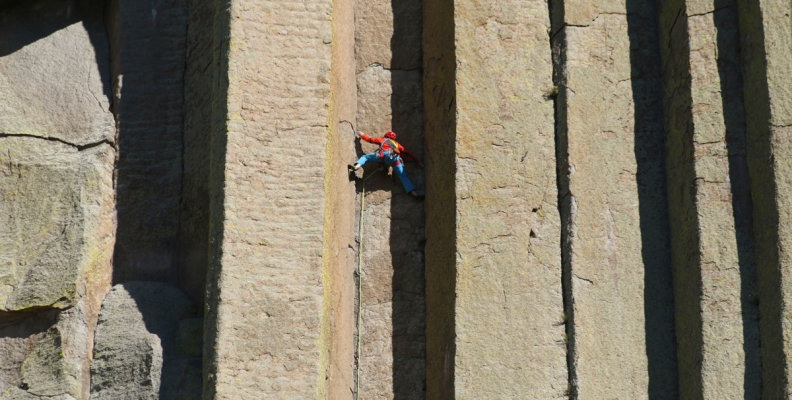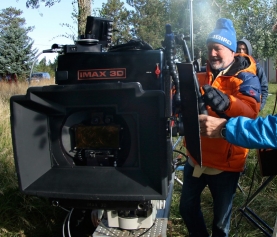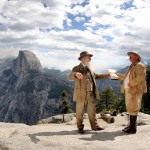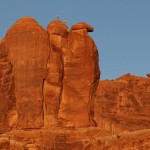America Wild: National Park Adventure’s itinerary set out to not only visit such legendary post-card landscapes as Yosemite and Yellowstone, but also to uncover some of America’s least seen jewels. These include the dramatically named Devils Tower National Monument, home to one of the most surreal marvels in America—the 1,267-foot (equivalent to 86 stories), improbably steep dome of igneous rock that erupts from the Black Hills of Wyoming.
A draw for rock climbers, this one-of-a-kind volcanic wonder that rises dramatically up out of a vast prairie has long been held sacred by local Native American tribes (who call it “Bear Lodge,” “Bear Mountain” or “Tree Rock,” among other names) and is also noted for its starring appearance in the sci-fi classic “Close Encounters of the Third Kind.” Having struck everyone who encountered it with awe, it was originally designated a National Monument by Theodore Roosevelt way back in 1906.
Climber Conrad Anker was one of the first on the production to recognize this place as one “that has a real power to it, because you’re surrounded by sacred Native American history.” Conrad and others on the production team met with National Park Service staff and more than 20 tribal elders and leaders to discuss the production. Out of respect for the tribes, the production did not conduct aerial cinematography near the Tower, nor climb to its peak. And as with all of its productions, MacGillivray Freeman left the site with no trace of its presence there.
“The thing I wanted to share about Devils Tower is that it looks like it could never be an act of nature,” muses director Greg MacGillivray. “You could imagine a clever architect designing it, you could imagine it being carved by a machine, but it seems almost impossible that a natural volcanic intrusion arose with those perfect 90-degree angles. It fills you with a reverence for what nature can do.”
The formation’s rare collection of massive, parallel cracks have made Devils Tower a major destination on many hardcore climbers’ bucket lists. The singular rock boasts hundreds of established climbing routes—ranging from the doable for amateur climbers to the desperate for even the pros.
“You can’t appreciate just how massive some of those cracks are until you get close up and then you realize just how tough this formation is to climb. It requires a kind of spider-like action that’s really exciting,” says producer Shaun MacGillivray. “But of course Conrad went right up it as if it was nothing.”
For the film, Conrad Anker chose a route colorfully named El Matador. It was first climbed in 1967 and today is considered a difficult (rated 10d) but rewarding classic. “It’s a crack that you stem your legs up—so it’s very interesting visually,” Anker comments. “It’s one of the most continuously challenging routes at Devils Tower and the nature of the crack is that you’re using all the features on it.”
Crack-climbing is a more physically dramatic art form than face-climbing—with climbers using their body parts as levers, jamming hands and feet at jig-saw tilts into the fissures until cliff, skin and bone meld together. It makes for exciting visual action—but took cast member Rachel Pohl to her physical edge.
“It was exciting to capture Rachel really pressing herself to achieve this climb on Devils Tower,” says MacGillivray. “It’s something most people will never experience, hanging off a sheer rock face hundreds of feet in the air, but it’s a wonderful way to see how special this place is.”
Pohl says she welcomed the intense challenge, but the wintry conditions made a daunting assignment even tougher. “That climb would still have been hard if I could have felt my hands, but not only were my legs maxed out…my fingers were completely numb! It really spoke to the theme of endurance,” she laughs. “It’s the kind of climbing where you leave nothing behind.”
Climbing Devils Tower is one thing—but filming climbing on Devils Tower is even more challenging, especially when you bring traditional film-based IMAX cameras into the mix.
“The biggest difficulty was just getting the camera up high on the formation,” acknowledges Greg MacGillivray. “Luckily, we were able to bring aboard Michael Brown, a terrific climber and cinematographer who worked with us on Alps and is working with us our new Everest film. He did some phenomenal rigging that allowed us to get the shots we wanted.”
Brown wrapped the fragile IMAX camera in foam and then hauled the heavy beast clipped to his harness, attaching it to the sedimentary rock of Devils Tower via an innovative variation on a tripod the MacGillivray Freeman Films crew has dubbed a “wall-pod.” “It was far from the easiest way to get the camera up on the cliff…but it was the best way,” quips director of photography Brad Ohlund. Adds Shaun MacGillivray. “It was the will, passion and expertise of our climbing photography team that made this precarious shoot possible.”
The crew constantly raced the weather. “You might have sunshine in the morning but then you might have dangerous lightning or even snow in the afternoon. For us, that meant working fast,” says Greg. “But for the climbers, it meant they often had to wait for the right conditions.”
Recalls cast member Max Lowe: “The clouds would roll in and we’d sit on a ledge waiting and waiting for the right light. I remember staring into the stunning black hills hoping to be able to move soon!”
Yet the rigors of Devils Tower also brought cast and crew closer. “A wonderful camaraderie developed,” says Greg. “We made bonds that lasted the whole shoot.”
That kind of camaraderie is something often heightened in trips to national parks, which have brought friends, families and even strangers together. There’s something unique about connections forged in the pure, primal air of the outdoors, says Pohl. “There are so many superficial ways of getting to know people these days—on your iPhone or Instagram—but when you’re outside with a friend even if you’re not talking, you know your friend is having the same thoughts about how incredible it is. The unspoken moments create a kinship difficult to find in other ways,” she observes.
Adds Lowe: “Our regular, daily lives can be very predictable. But when you’re outside there are many unknowns so you really come to depend on the people you’re with. It’s been really cool exploring wild places with my dad, for example, because it’s a rare situation where you’re both learning and sharing in this really powerful knowledge. That’s not something you get indoors often.”








